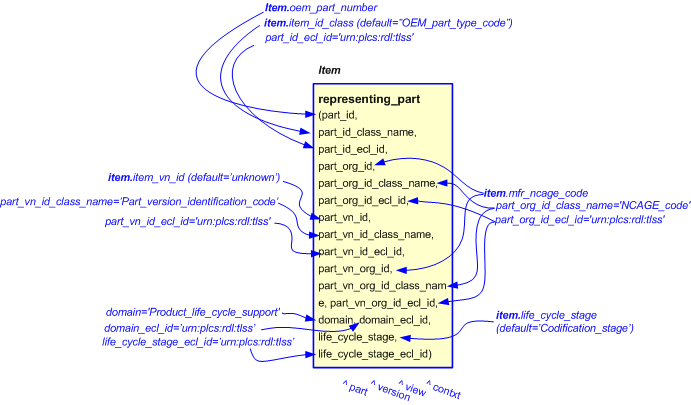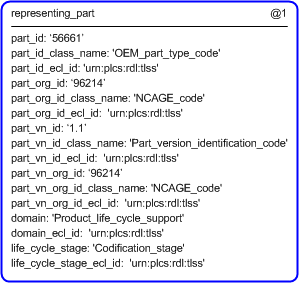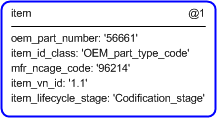Template:— item (itm)
Context:— UK_Defence |
Date: 2010/03/16 14:54:12
Revision: 1.3
|
This section specifies the template item.
NOTE
The template has been defined in the context of
UK_Defence.
Refer to the business context for details of related templates.
NOTE
An explanation of a template and the associated instantiation path is
provided in the
Template overview
section.
This template describes how to represent a item of design. It has been configured for the purposes of Nato Codification, but
could be used elsewhere. It is specifically based upon the representing_part template, which is specialised for (at least)
one business DEX usage.
The degree of specialisation is minor, specifiying that a manufacturers CAGE code and part number be provided in the instantiation
of the template, as these are minimum requirements for each item for codification. It has been chosen as a business template
because several aspects of the reference data are set for the usage in codification, thereby making it a business template.
The EXPRESS-G diagram in
Figure
1
shows the templates and EXPRESS entities that are required
to represent the template
"item".
The text highlighted in blue shows the template parameters.
The information model for the item template is that of a modified representation for a Part. The item template has been configured
to collect only the basic information required by the codification business DEX. It automatically creates a number of parameters
which are assumed to be set for this particular process. The optional characterization of representing_part is 'inherited'
by the 'item' template.
Figure 1 — An EXPRESS-G representation of the Information model for item
The graphic for the template to be used in other EXPRESS-G diagrams
is shown in Figure
2
below.
The item template requires parameters for the original equipment manufacturer's part number and the manufacturers NCAGE code.
The item version id is optional. This specification of precise parameters allows the associated refererence data to be automatically
assigned as these have been assumed to be set by the analysis of the business DEX for this process. The lifecycle and domain
parameters are likewise also known for the process covered by this business DEX. The location of the reference data which
has been pre-determined, have also been identified within the scope of the standard plcs reference data library, which further
reduces the required set of parameters to be input.
Figure 2 — The graphical representation of the item template
The following input parameters are defined for this template:
The following classes and their sub-classes can be used:
classifications: [OEM_part_type_code]![[warning:]](../../../../../../images/dex/warning.gif) Error RDL4: The URI urn:plcs:rdl:uk_defence is not listed in dexlib/data/refdata/rdl_index.xml[Product_specification_code]
Error RDL4: The URI urn:plcs:rdl:uk_defence is not listed in dexlib/data/refdata/rdl_index.xml[Product_specification_code]![[warning:]](../../../../../../images/dex/warning.gif) Error RDL4: The URI urn:plcs:rdl:uk_defence is not listed in dexlib/data/refdata/rdl_index.xml
Error RDL4: The URI urn:plcs:rdl:uk_defence is not listed in dexlib/data/refdata/rdl_index.xml
The ncage identifier of the organization that provides the part number
The version identifier of the item
The following classes and their sub-classes can be used:
The following reference parameters are defined for this template:
Allow the
Part
entity instantiated in this path to be referenced when this template is used.
Note: The
Part
entity can be referenced in a template path by:
%^target = $item.item%
where
target
is the parameter to which the
Part
is bound.
Allow the
Part_version
entity instantiated in this path to be referenced when this template is used.
Note: The
Part_version
entity can be referenced in a template path by:
%^target = $item.item_version%
where
target
is the parameter to which the
Part_version
is bound.
Allow the
Part_view_definition
entity instantiated in this path to be referenced when this template is used.
%^target = $item.item_view%
%^target = $item.item_contxt%
The instantiation path shown below specifies the entities that are to be
instantiated by the template.
A description of templates and the syntax for the instantiation path is
provided in the
Templates Help/Information section.
-- Call Representing_part template with the input parameters and those pre-determined for part number and NCAGE code etc..
/
representing_part(
part_id=@oem_part_number,
part_id_class_name=@item_id_class,
part_id_ecl_id='urn:plcs:rdl:uk_defence',
part_org_id=@mfr_ncage_code,
part_org_id_class_name='NCAGE_code',
part_org_id_ecl_id='urn:plcs:rdl:std',
part_vn_id=@item_vn_id,
part_vn_id_class_name='Part_version_identification_code',
part_vn_id_ecl_id='urn:plcs:rdl:std',
part_vn_org_id=@mfr_ncage_code,
part_vn_org_id_class_name='NCAGE_code',
part_vn_org_id_ecl_id='urn:plcs:rdl:std',
domain='Product_life_cycle_support',
domain_ecl_id='urn:plcs:rdl:std',
life_cycle_stage=@item_lifecycle_stage,
life_cycle_stage_ecl_id='urn:plcs:rdl:std')/
-- re-direct the output from the call.. %^item = $representing_part.part%
%^item_version = $representing_part.version%
%^item_view = $representing_part.view%
%^item_contxt = $representing_part.contxt%
The instance diagram in Figure
3
shows an example of the EXPRESS entities and templates that are instantiated by the template:
/item(oem_part_number='56661', mfr_ncage_code='96214', item_vn_id='1.1')/
(an illustration of the consolidated item template is shown in
Figure
4 below.)
Figure 3 — Entities instantiated by item template
The instance diagram in
Figure
4
shows the graphic symbol for the template that is to be
used in other instance diagrams. The example template is:
/item(oem_part_number='56661', mfr_ncage_code='96214', item_vn_id='1.1')/
Figure 4 — Instantiation of item template
Characterizations
No common characterizations of the template
item
have been identified. However, the ISO 10303-239 EXPRESS model
may enable other assignments to the entities instantiated by the template.




